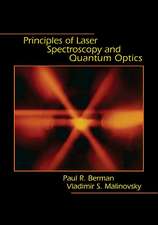Ultraclean Surface Processing of Silicon Wafers: Secrets of VLSI Manufacturing
Editat de Takeshi Hattori Traducere de T. Hattori, S. Heusler, J.P. Webben Limba Engleză Hardback – 17 sep 1998
| Toate formatele și edițiile | Preț | Express |
|---|---|---|
| Paperback (1) | 1833.78 lei 6-8 săpt. | |
| Springer Berlin, Heidelberg – 7 dec 2010 | 1833.78 lei 6-8 săpt. | |
| Hardback (1) | 1840.11 lei 6-8 săpt. | |
| Springer Berlin, Heidelberg – 17 sep 1998 | 1840.11 lei 6-8 săpt. |
Preț: 1840.11 lei
Preț vechi: 2244.04 lei
-18% Nou
Puncte Express: 2760
Preț estimativ în valută:
352.12€ • 376.52$ • 293.58£
352.12€ • 376.52$ • 293.58£
Carte tipărită la comandă
Livrare economică 17 aprilie-01 mai
Preluare comenzi: 021 569.72.76
Specificații
ISBN-13: 9783540616726
ISBN-10: 3540616721
Pagini: 648
Ilustrații: XXVIII, 616 p.
Dimensiuni: 140 x 216 x 27 mm
Greutate: 1.12 kg
Ediția:1998
Editura: Springer Berlin, Heidelberg
Colecția Springer
Locul publicării:Berlin, Heidelberg, Germany
ISBN-10: 3540616721
Pagini: 648
Ilustrații: XXVIII, 616 p.
Dimensiuni: 140 x 216 x 27 mm
Greutate: 1.12 kg
Ediția:1998
Editura: Springer Berlin, Heidelberg
Colecția Springer
Locul publicării:Berlin, Heidelberg, Germany
Public țintă
ResearchCuprins
I. Introduction.- 1. Ultraclean Technology for VLSI Manufacturing: An Overview.- II. Influence of Contamination on Silicon Device Characteristics.- 2. Influence of Silicon Crystal Quality on Device Characteristics.- 3. Influence of Contaminants on Device Characteristics.- 4. Influence of Metallic Contamination on Dielectric Degradation of MOS Structures.- 5. Influence of Micro-Roughness on Device Characteristics.- III. Mechanisms of Particle Adhesion on Wafer Surfaces.- 6. Particle Deposition in Air.- 7. Particle Deposition in Plasma.- 8. Particle Deposition in Vacuum.- 9. Particle Adhesion in Liquids.- 10. Particle Adhesion and Removal on Wafer Surfaces in RCA Cleaning.- 11. Effects of Electrostatic Charge on Particle Adhesion on Wafer Surfaces.- IV. Analysis and Evaluation of Silicon Wafer Surfaces: Fundamentals.- 12. Measurement of Particles on Wafer Surfaces.- 13. Analysis and Evaluation of Impurities on Wafer Surfaces.- 14. Analysis and Evaluation of Molecules Adhered to Wafer Surfaces.- 15. Electrical Evaluation of Metallic Impurities on Wafer Surfaces.- 16. Analysis of Microscopic Areas on Wafer Surfaces Using STM/AFM.- V. Analysis and Evaluation of Wafer Surfaces: Applications to Semiconductor Manufacturing Lines.- 17. Detection and Analysis of Particles in Production Lines.- 18. Pattern Defect Monitoring in Production Lines.- 19. Clean Level Monitoring in Production Lines.- 20. Analysis of Defects in Devices and Silicon Crystals in Production Lines.- VI. Ultraclean Technology for Wafer Processes and Equipment.- 21. Oxidation and Diffusion.- 22. CVD (Part 1): Atmospheric Pressure/Low-Pressure CVD.- 23. CVD (Part 2): Plasma CVD.- 24. CVD (Part 3): Metal CVD.- 25. Physical Vapor Deposition.- 26. Dry Etching (Part 1): Particulate Contamination Due to Dry Etching.-27. Dry Etching (Part 2): Influence of Chemical Contamination and Defects on Dry Etching.- 28. Ion Implantation.- 29. Lithography.- 30. CMP.- 31. Cluster Tools.- VII. Cleaning Silicon Wafer Surfaces.- 32. Trends in Wafer Cleaning Technology.- 33. Wet Cleaning (Part 1): Removal of Particulate Contaminants.- 34. Wet Cleaning (Part 2): Removal of Metallic Contaminants.- 35. Wet Cleaning (Part 3): Removal of Organic Contaminants.- 36. Wet Cleaning (Part 4): Micro-Roughness and COPs Created by SC-1.- 37. Wafer Drying After Wet Cleaning.- 38. Watermarks: Generation, Control, and Removal.- 39. Physical Cleaning.- 40. Dry Cleaning.- VIII. Wafer-Cleaning-Related Issues.- 41. HF Vapor Cleaning Technology.- 42. Native Oxide Films and Chemical Oxide Films.- 43. Hydrogen Termination: The Ideally Finished Silicon Surface.- 44. Adsorption of Organic Volatiles on Silicon Surfaces and Their Removal by Wet Cleaning.- 45. Wafer Carrier Cleaning.- 46. Goals for Next-Generation Wafer Cleaning Technology.
Textul de pe ultima copertă
The contamination of wafer surfaces with particles arising from the processing equipment is the main reason for yield losses in the manufacturing of VLSI devices. The starting point for the control of contamination must be the surface of the wafer itself and not just the reduction of contamination in the ambient air or in the gases, chemicals and water used for production. A totally new concept for clean surface processing is introduced here. Some fifty distinguished researchers and engineers from the leading Japanese semiconductor companies, such as NEC, Hitachi, Toshiba, Sony and Panasonic, as well as from several universities reveal to us for the first time the secrets of these highly productive institutions. They describe the techniques and equipment necessary for the preparation of clean high-quality semiconductor surfaces as a first step in high-yield/high-quality device production. This book thus opens the door to the manufacturing of reliable nanoscale devices and will be extremely useful for every engineer, physicist and technician involved in the production of silicon semiconductor devices.
Caracteristici
Handbook on most advanced technologies in surface processing of silicon wafers.

















